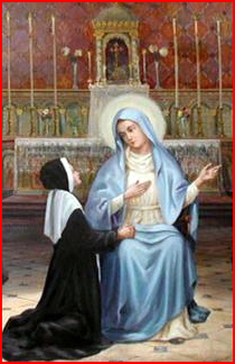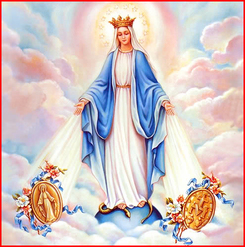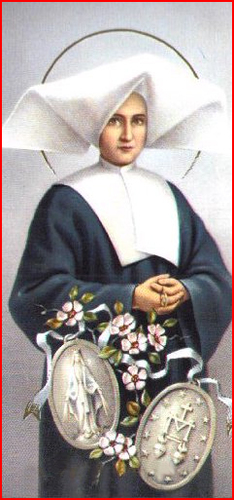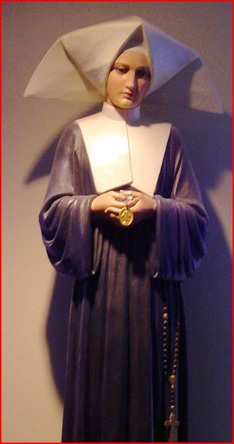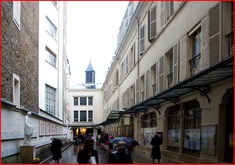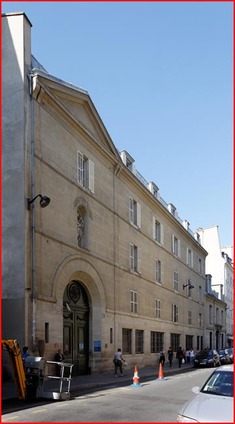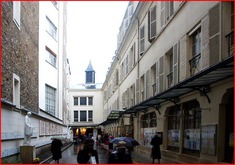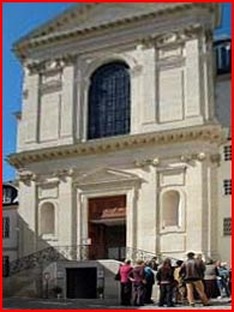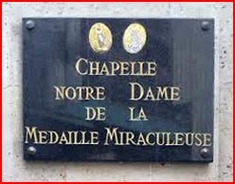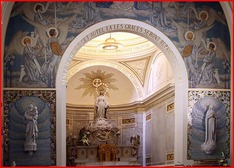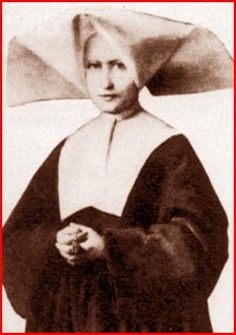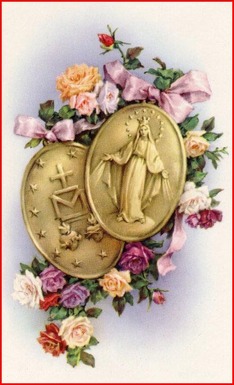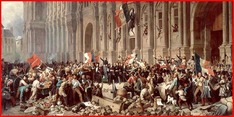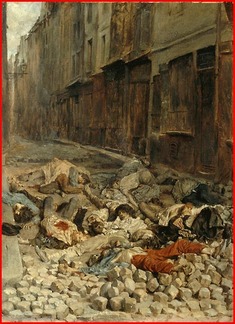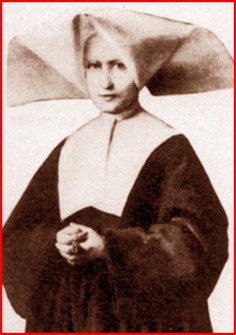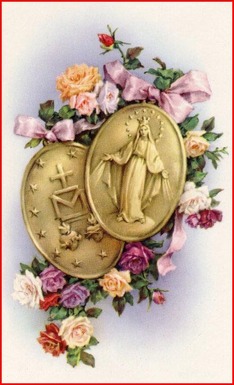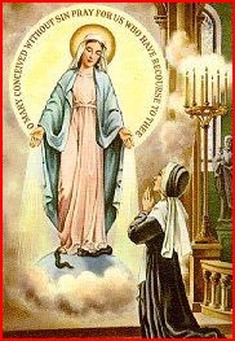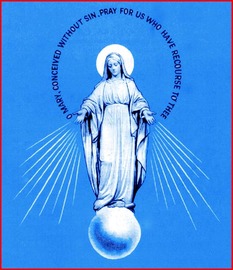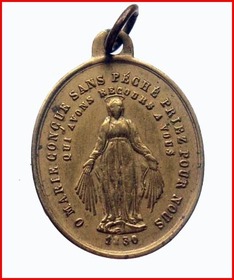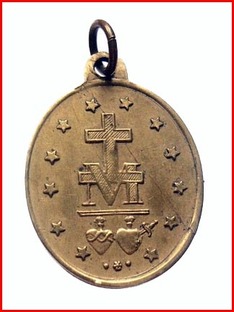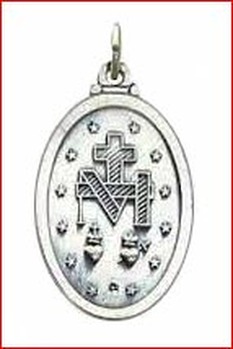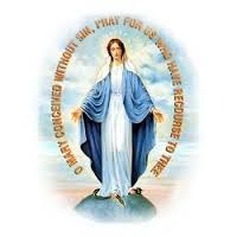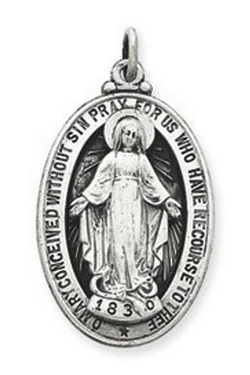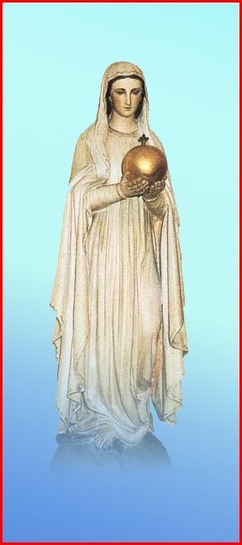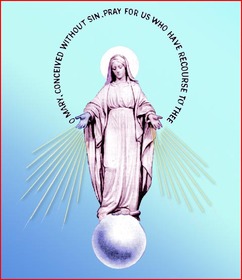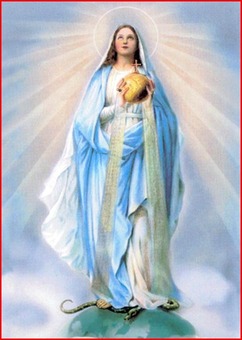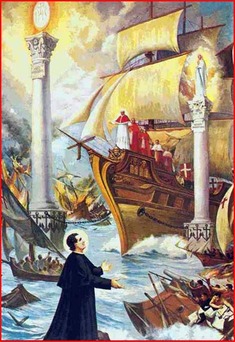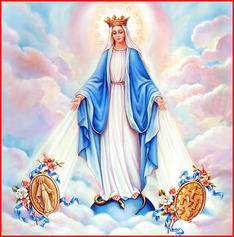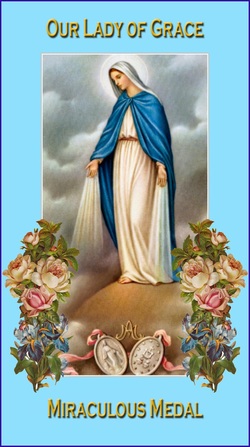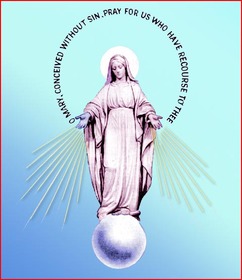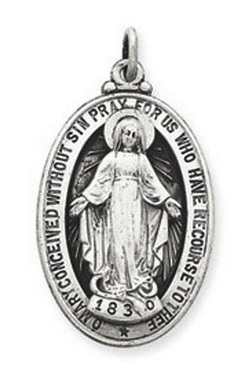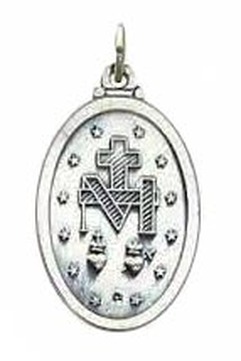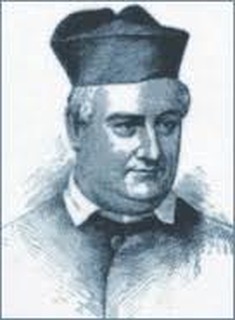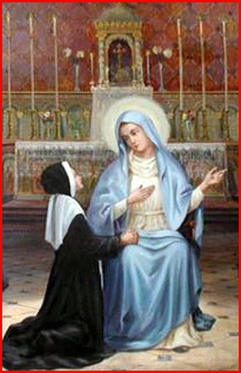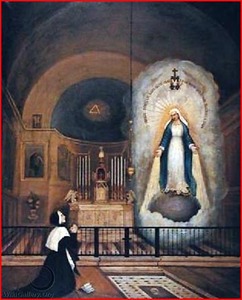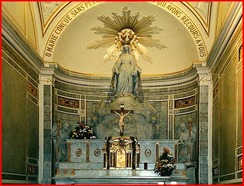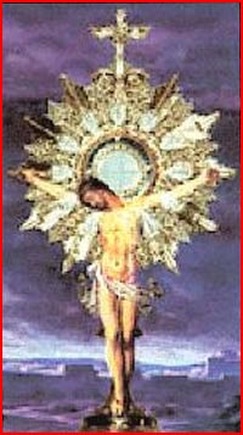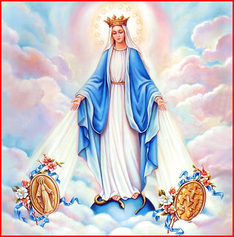| Devotion to Our Lady |
|
- Homepage
-
Daily Thoughts
- 2023 October Daily Thoughts
- Daily Thoughts Lent 2020
- Daily Thoughts for Advent 2019
- Daily Thoughts for October 2019
- Daily Thoughts for September 2019
- Daily Thoughts for August 2019
- Daily Thoughts for July
- Daily Thoughts for June
- Daily Thoughts for Easter 2019
- Daily Thoughts for Lent 2019
- Daily Thoughts for Christmas
- Daily Thoughts Easter 2022
- Sacred Heart
- Holy Ghost
-
Spiritual Life
- Holy Mass Explained
- First Friday Devotions
- First Saturday Devotions
- The Mercy of God
- Vocations
- The Path Everyone Must Walk >
- Gift of Failure
- Halloween or Hell-O-Ween?
- Ignatian Spiritual Exercises >
- Meditation is Soul-Saving
- Spiritual Communion
- Miraculous Medal
- Enrollment in Miraculous Medal
- St. Benedict Medal
- Holy Water
- Advice on Prayer
- Your Daily Mary
-
Prayers
- September Devotions
- Seven Sorrows of Our Lady
-
Novenas
>
- NV-Help of Christians
- NV-Nativity of Our Lady
- NV-Seven Sorrows
- NV- Sorrowful Heart
- NV-Pope St Pius X
- NV-La Salette
- NV-St Michael Archangel
- NV-Immaculate Heart
- NV-Assumption
- NV-Novena for Fathers
- NV-Novena for Your Mother
- NV-St Raphael Archangel
- NV-Souls in Purgatory
- NV-All Saints Day
- NV-Christ the King
- NV-Divine Motherhood
- NV-Guardian Angels
- NV-Rosary
- NV-Mirac Med
- NV- Imm Conc
- NV - Guadalupe
- NV - Nativity of Jesus
- NV-Epiphany
- NV-OL Good Success
- NV-Lourdes
- NV-St Patrick
- NV-St Joseph
- NV-Annunciation
- NV-St Louis de Montfort
- NV-OL Good Counsel
- NV-Last Supper
- NV-Passion
- NV-Pentecost
- NV-Ascension
- NV-Sacred Heart
- NV-Sacred Heart & Perpetual Help
- NV-Corpus Christi
- NV-OL of Perpetual Help
- NV-Queenship BVM
- NV-OL of Mount Carmel
- NV-St Mary Magdalen
- NV- Im Hrt
- August Devotions to IHM
- Immaculate Heart of Mary
- Litany of Dependence
- Prayers to St Mary Magdalen
- Prayers in Times of Sickness Disease & Danger
- Holy Souls in Purgatory
- Meditations on the Litany of Our Lady
- Special Feast Days
- Prayers to Mary (Mon-Sun)
- Litanies to Our Lady >
- Various & Special Needs
- Our Lady of the Rosary
- Our Lady of Mt. Carmel
- Our Lady of Perpetual Help
- Our Lady of Guadalupe
- Other titles of Our Lady
-
Rosary
- Downloads
- Consecration
- Easter Season
-
Holy Week
- Last Seven Words of Jesus >
- Characters of Passion >
- The Last Days of Christ
- Before Palm Sunday
- Palm Sunday
- Monday in Holy Week
- Tuesday in Holy Week
- Wednesday in Holy Week
- Holy Thursday (Last Supper)
- Holy Thursday (Agony & Arrest)
- Night Vigil with Christ
- Good Friday (Pilate & Herod)
- Good Friday (Way of Cross & Crucifixion)
- Saturday in Holy Week
-
Lent
- Ideas for Lent
- Daily Lenten Planner
- Daily Lenten Liturgy
- From Cold to Hot
- Lent with Aquinas
- Lent with Dom Gueranger
- Virtues for Lent
- History of Penance
- How Expensive is Sin?
- Confession of Sins
- Letter to Friends of the Cross
- Sermons for Lent
- Stations of the Cross >
- Lenten Prayers
- 7 Penitential Psalms
- Lenten Psalms SUN
- Lenten Psalms MON
- Lenten Psalms TUE
- Lenten Psalms WED
- Lenten Psalms THU
- Lenten Psalms FRI
- Lenten Psalms SAT
- Lenten Laughs
- Septuagesima
-
Christmas
- Epiphany Explained
- Suggestions for Christmas
- Food For Thought
- Christmas with Aquinas
- Christmas with Dom Gueranger
- Christmas Prayers
- Candles & Candlemas
- Christmas Sermons
- Christmas Prayers SUN
- Christmas Prayers MON
- Christmas Prayers TUE
- Christmas Prayers WED
- Christmas Prayers THU
- Christmas Prayers FRI
- Christmas Prayers SAT
- Twelve Days of Christmas >
-
Advent Journey
- Purgatory
- Christ the King
- Legion of Mary
- Scapular
-
Saints
-
Martyrs for the Faith
>
- Your Daily Martyr >
- All 365 Days of Martyrs
- Cristeros
- St Valentine & Valentine's Day
- Martyrs--Thomas Becket
- Martyrs--John the Apostle
- Holy Machabees
- Age of Martyrdom
- Carmelites of Compiegne
- Martyrs--Peter & Paul
- Martyrs--John the Baptist
- Martyrs--Andrew
- Martyrs--James the Great
- Martyrs--North American
- Martyrs--Seven Holy Sleepers
- Martyrs--Afra
- School of Martyrdom
- Martyrs--Christina
- Desert Saints >
- Saints for Sinners >
- Saints of Mary >
- History of All Saints Day
-
Martyrs for the Faith
>
- Precious Blood
- Synod 2023
-
Catechism
- Catechism Lesson 1
- Catechism Lesson 2
- Catechism Lesson 3
- Catechism Lesson 4
- Catechism Lesson 5
- Catechism Lesson 6
- Catechism Lesson 7
- Catechism Lesson 8
- Catechism Lesson 9
- Catechism Lesson 10
- Catechism Lesson 11
- Catechism Lesson 12
- Catechism Lesson 13
- Catechism Lesson 14
- Catechism Lesson 15
- Catechism Lesson 16
- Catechism Lesson 17
- Catechism Lesson 18
- Catechism Lesson 19
- Catechism Lesson 20
- Catechism Lesson 21
- Catechism Lesson 22
- Bible Study
-
Calendar
- Miracles
- Apparitions
- Shrines
- Prophecies
- Angels Homepage
- Hell
-
Church Crisis
- Conspiracy Theories
- Amazon Synod 2019 >
- Liberalism & Modernism
- Modernism--Encyclical Pascendi
- Modernism & Children
- Modernism--Documents
- The Francis Pages
- Church Enemies on Francis
- Francis Quotes
- Amoris Laetitia Critique
- Danger of Ignorance (Pius X)
- Restore all In Christ (Pius X)
- Catholic Action (Pius X)
- Another TITANIC Disaster?
- The "Errors of Russia"
- CRISIS PRAYERS
- Election Novena 2024
- The Anger Room
- War Zone
- Life of Mary
- Spiritual Gym
- Stupidity
- Coronavirus and Catholicism
- History & Facts
- Books
- Catholic Family
- Children
- Daily Quiz
-
Novena Church & Pope
- Day 01 Church-Pope Novena
- Day 02 Church-Pope Novena
- Day 03 Church-Pope Novena
- Day 04 Church-Pope Novena
- Day 05 Church-Pope Novena
- Day 06 Church-Pope Novena
- Day 07 Church-Pope Novena
- Day 08 Church-Pope Novena
- Day 09 Church-Pope Novena
- Day 10 Church-Pope Novena
- Day 11 Church-Pope Novena
- Day 12 Church-Pope Novena
- Day 13 Church-Pope Novena
- Day 14 Church-Pope Novena
- Day 15 Church-Pope Novena
- Day 16 Church-Pope Novena
- Day 17 Church-Pope Novena
- Day 18 Church-Pope Novena
- Day 19 Church-Pope Novena
- Day 20 Church-Pope Novena
- Day 21 Church-Pope Novena
- Day 22 Church-Pope Novena
- Day 23 Church-Pope Novena
- Day 24 Church-Pope Novena
- Day 25 Church-Pope Novena
- Day 26 Church-Pope Novena
- Day 27 Church-Pope Novena
- Day 28 Church-Pope Novena
- Day 29 Church-Pope Novena
- Day 30 Church-Pope Novena
- Day 31 Church-Pope Novena
- Day 32 Church-Pope Novena
- Day 33 Church-Pope Novena
- Day 34 Church-Pope Novena
- Day 35 Church-Pope Novena
- Day 36 Church-Pope Novena
- Day 37 Church-Pope Novena
- Day 38 Church-Pope Novena
- Day 39 Church-Pope Novena
- Day 40 Church-Pope Novena
- Day 41 Church-Pope Novena
- Day 42 Church-Pope Novena
- Day 43 Church-Pope Novena
- Day 44 Church-Pope Novena
- Day 45 Church-Pope Novena
- Day 46 Church-Pope Novena
- Day 47 Church-Pope Novena
- Day 48 Church-Pope Novena
- Day 49 Church-Pope Novena
- Day 50 Church-Pope Novena
- Day 51 Church-Pope Novena
- Day 52 Church-Pope Novena
- Day 53 Church-Pope Novena
- Day 54 Church-Pope Novena
- Penance Novena
- Daily WeAtheR Forecast
RELATED LINKS
| Novena to Our Lady of the Miraculous Medal | The Facts and Story of the Miraculous Medal |
| Enrollment in the Miraculous Medal | The Life of St. Catherine Laboure | The Miracles of the Miraculous Medal |
| Novena to Our Lady of the Miraculous Medal | The Facts and Story of the Miraculous Medal |
| Enrollment in the Miraculous Medal | The Life of St. Catherine Laboure | The Miracles of the Miraculous Medal |
CLICK BELOW FOR THE NOVENA OF YOUR CHOICE (not all links are activated)
| PRAYERS (main page) | NOVENAS (main page) | EPIPHANY OF OUR LORD Jan 6 | OUR LADY OF GOOD SUCCESS Feb 2 | OUR LADY OF LOURDES Feb 11 | | ST. PATRICK Mar 17 | ST. JOSEPH Mar 19 | ANNUNCIATION March 25 | LAST SUPPER | PASSION OF OUR LORD | OUR LADY OF SORROWS Passiontide |
| OUR LADY OF GOOD COUNSEL Apr 26 | ST. LOUIS DE MONTFORT Apr 28 | QUEENSHIP OF MARY May 31 | ASCENSION OF OUR LORD | PENTECOST | | CORPUS CHRISTI | SACRED HEART | SACRED HEART & OUR LADY OF PERPETUAL HELP June 27 | OUR LADY OF PERPETUAL HELP June 27 |
| OUR LADY OF MT. CARMEL July 16 | ST. MARY MAGDALEN Jul 22 | ASSUMPTION Aug 15 | IMMACULATE HEART OF MARY Aug 22 Version 1 |
| IMMACULATE HEART Aug 22 Version 2 | POPE ST. PIUS X Sep 3 | NATIVITY OF OUR LADY Sept 8 | SEVEN SORROWS OF OUR LADY Sept 15 |
| OUR LADY OF LA SALETTE Sept 19 | ST MICHAEL ARCHANGEL Sep 29 | GUARDIAN ANGELS Oct 2 | OUR LADY OF THE ROSARY Oct 7 |
| DIVINE MOTHERHOOD OF OUR LADY Oct 11 | ST. RAPHAEL ARCHANGEL Oct 24 | CHRIST THE KING | ALL SAINTS DAY | SOULS IN PURGATORY | MIRACULOUS MEDAL Nov. 27 | IMMACULATE CONCEPTION Dec 8 | OUR LADY OF GUADALUPE Dec 12 | NATIVITY OF OUR LORD Dec 25 |
| NOVENA FOR MOTHERS | NOVENA FOR FATHERS |
| OTHER TITLES OF OUR LADY |
| PRAYERS (main page) | NOVENAS (main page) | EPIPHANY OF OUR LORD Jan 6 | OUR LADY OF GOOD SUCCESS Feb 2 | OUR LADY OF LOURDES Feb 11 | | ST. PATRICK Mar 17 | ST. JOSEPH Mar 19 | ANNUNCIATION March 25 | LAST SUPPER | PASSION OF OUR LORD | OUR LADY OF SORROWS Passiontide |
| OUR LADY OF GOOD COUNSEL Apr 26 | ST. LOUIS DE MONTFORT Apr 28 | QUEENSHIP OF MARY May 31 | ASCENSION OF OUR LORD | PENTECOST | | CORPUS CHRISTI | SACRED HEART | SACRED HEART & OUR LADY OF PERPETUAL HELP June 27 | OUR LADY OF PERPETUAL HELP June 27 |
| OUR LADY OF MT. CARMEL July 16 | ST. MARY MAGDALEN Jul 22 | ASSUMPTION Aug 15 | IMMACULATE HEART OF MARY Aug 22 Version 1 |
| IMMACULATE HEART Aug 22 Version 2 | POPE ST. PIUS X Sep 3 | NATIVITY OF OUR LADY Sept 8 | SEVEN SORROWS OF OUR LADY Sept 15 |
| OUR LADY OF LA SALETTE Sept 19 | ST MICHAEL ARCHANGEL Sep 29 | GUARDIAN ANGELS Oct 2 | OUR LADY OF THE ROSARY Oct 7 |
| DIVINE MOTHERHOOD OF OUR LADY Oct 11 | ST. RAPHAEL ARCHANGEL Oct 24 | CHRIST THE KING | ALL SAINTS DAY | SOULS IN PURGATORY | MIRACULOUS MEDAL Nov. 27 | IMMACULATE CONCEPTION Dec 8 | OUR LADY OF GUADALUPE Dec 12 | NATIVITY OF OUR LORD Dec 25 |
| NOVENA FOR MOTHERS | NOVENA FOR FATHERS |
| OTHER TITLES OF OUR LADY |
NOVENA TO OUR LADY OF THE MIRACULOUS MEDAL
feast day : November 27th
feast day : November 27th
For the feast day, begin on November 18th and end on November 26th
Or, you could say it in any month beginning for example on the First Saturday of the month.
However, do not feel obligated to particular dates, pray it any time you want.
Or, you could say it in any month beginning for example on the First Saturday of the month.
However, do not feel obligated to particular dates, pray it any time you want.
What is a Novena?
A novena is a traditional devotion consisting of specific prayers recited on nine successive days. Besides being a form of praise, a novena is frequently offered for a particular intention. The first novena took place in the Cenacle, during the nine days preceding Pentecost, or the coming of the Holy Ghost. As a regular popular custom, this practice began in 12th century Christianity and continues to be beneficial today as a way of praying for healing, protection or other blessings for ourselves or others.
This particular novena is prayed to God through the intercession of Our Lady of Miraculous Medal (Our Lady of Grace). In praying this Novena, as in the case of all prayer, it is good to begin by opening ourselves wholeheartedly to God's will, offering a simple act of trust in God's wisdom and in His providential love for us all, that disposes all things for the ultimate benefit of our souls and their salvation.
How to Pray This Novena
This novena is based on the message of Our Lady of the Miraculous Medal. Each day of the novena is divided into the following parts: (1) a quote from Our Lord, Our Lady or a Saint for reflection; (2) a quote from St. Catherine Labouré or some other relevant person; (3) a Meditation; (4) a Prayer; (5) after mentioning your intention, pray the Our Father and the Hail Mary; (6) a Closing Prayer (invocation to Our Lady of the Miraculous Medal).
A novena is a traditional devotion consisting of specific prayers recited on nine successive days. Besides being a form of praise, a novena is frequently offered for a particular intention. The first novena took place in the Cenacle, during the nine days preceding Pentecost, or the coming of the Holy Ghost. As a regular popular custom, this practice began in 12th century Christianity and continues to be beneficial today as a way of praying for healing, protection or other blessings for ourselves or others.
This particular novena is prayed to God through the intercession of Our Lady of Miraculous Medal (Our Lady of Grace). In praying this Novena, as in the case of all prayer, it is good to begin by opening ourselves wholeheartedly to God's will, offering a simple act of trust in God's wisdom and in His providential love for us all, that disposes all things for the ultimate benefit of our souls and their salvation.
How to Pray This Novena
This novena is based on the message of Our Lady of the Miraculous Medal. Each day of the novena is divided into the following parts: (1) a quote from Our Lord, Our Lady or a Saint for reflection; (2) a quote from St. Catherine Labouré or some other relevant person; (3) a Meditation; (4) a Prayer; (5) after mentioning your intention, pray the Our Father and the Hail Mary; (6) a Closing Prayer (invocation to Our Lady of the Miraculous Medal).
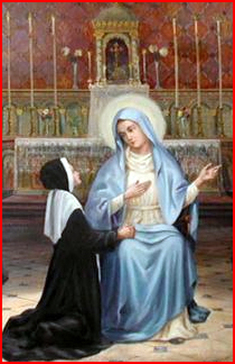 On the night of July 18-19, at the convent of the Daughters of Charity, on the Rue du Bac, in Paris,1830, a young child (perhaps her guardian angel) awakened Sister (now Saint) Catherine Labouré, a novice in the community of the Daughters of Charity in Paris, and summoned her to the chapel. There she met with the Virgin Mary and spoke with her for several hours. During the conversation, Mary said to her, “My child, I am going to give you a mission.”  On November 27th, 1830, at the convent of the Daughters of Charity, on the Rue du Bac, in Paris, Our Lady appeared to St. Catherine Labouré, a novice in the community. She showed Catherine the design of a medal that she wanted to be made and distributed to all the world. The medal was initially known as the Medal of the Immaculate Conception or the Medal of Our Lady of Grace, but due to the many miracles that the medal seemed to produce, it received the popular title of "The Miraculous Medal." |
SECOND DAY OF THE NOVENA
New meditations for each day Theme: God Entrusts Us With A Mission. Our Lady Says: Mary said to St. Catherine Labouré: "My child, the good God wishes to entrust to you a mission. You will have much to suffer, but you will rise above those sufferings by reflecting that what you do is for the glory of God. You will be contradicted, but do not fear; you will have the grace to do what is necessary. Have confidence, do not be afraid.” St. Catherine Labouré says: "I asked her the meaning of everything I had seen, and she deigned to explain it to me. I could not say how long I stayed with her. When she left, it was as if she faded away, becoming a shadow which moved toward the tribune, the way she had come. I got up from the steps of the altar and saw that the child was where I had left him. He said: 'She is gone!' "We went back the same way, always surrounded with light, the child still keeping to the left. I believe that this child was my Guardian Angel, who showed himself that he might take me to see the Blessed Virgin, for I had often prayed to him to obtain this favor for me. He was dressed in white, and shone with a mysterious light that was more resplendent than light itself; he appeared to be four or five years old. Having returned to my bed, I heard two o'clock strike. I slept no more that night." Meditation: "The good God wishes to entrust to you a mission." This is almost an echo of Our Lady's own plight at the Annunciation. God entrusted Our Lady with a mission, to bring the Son of God into this world so that He could start His work of Redemption. Here we see St. Catherine Labouré being entrusted with a mission that would effectively be the 'Incarnation' of the 'Age of Mary'. The apparitions of Our Lady at the convent of the Daughters of Charity, on the Rue du Bac, in Paris, was, in a manner of speaking, the conception or beginning of what we are still living—the Age of Mary. It is a time where Mary humbly takes the spotlight and it will not end until she brings about the Triumph of her Immaculate Heart. We, too, have a part in this mission. Just as Our Lady told Lucia at Fatima, that her mission was to establish devotion to her Immaculate Heart: "I shall take Francisco and Jacinta soon, but you will remain a little longer, since Jesus wishes you to make me known and loved on Earth. He wishes also for you to establish devotion in the world to my Immaculate Heart." This also has to be our mission, for as the Fr. Faber writes in his Preface of his own translation of St. Louis de Montfort's True Devotion to Mary: "What is the remedy that is wanted? What is the remedy indicated by God Himself? If we may rely on the disclosures of the saints, it is an immense increase of devotion to our Blessed Lady; but, remember, nothing short of an immense one! ... Mary is not half enough preached. Devotion to her is low and thin and poor! ... It is the miserable, unworthy shadow which we call our devotion to the Blessed Virgin that is the cause of all these wants and blights, these evils and omissions and declines! Yet, if we are to believe the revelations of the saints, God is pressing for a greater, a wider, a stronger, quite another devotion to His Blessed Mother! I cannot think of a higher work or a broader vocation for anyone than the simple spreading of this peculiar devotion of the Venerable Grignion De Montfort!" "You will have much to suffer, but you will rise above those sufferings by reflecting that what you do is for the glory of God." It seems that all God and Our Lady want to do is spread suffering! At the Last Supper, Our Lord said to His beloved Apostles: "Amen, amen I say to you, that you shall lament and weep, but the world shall rejoice; and you shall be made sorrowful" (John 16:20). Our Lady said to St. Bernadette at Lourdes: "I do not promise to make you happy in this world, but in the next." At Fatima, the angel said to the three children: "Accept and bear with submission the sufferings that the Lord may send you.” Our Lady would later repeat the same idea to the children, saying: "Are you willing to offer yourselves to God and bear all the sufferings He wills to send you? ... Then you are going to have much to suffer, but the grace of God will be your comfort." Here, to St. Catherine, she says that she, too, will have much to suffer. Suffering is touchstone of the true Christian, who wants to take up his cross and follow Christ. Suffering is the only way to Heaven. There is no other. The superficial (and arguably false) Catholics of our day wish to go to Heaven without suffering anything or suffering minimally. That is not God's way. Ask the souls in Purgatory! "You will be contradicted, but do not fear; you will have the grace to do what is necessary!" It is the lot or fate of the Christian to be a sign of contradiction, just like Jesus. Simeon prophesied that same thing of Jesus: "...and said to Mary His mother: Behold this Child is set for the fall, and for the resurrection of many in Israel, and for a sign which shall be contradicted" (Luke 2:34). Contradiction comes from two Latin words: contra (against) and dicere, dictus (to speak). In other words, it means "speaking against" and "being spoken against". At her apparition in Akita, Japan, Our Lady said that those who were devoted to her, would be contradicted by their colleagues: "The priests who venerate me will be scorned and opposed by their confreres" (Our Lady of Akita, October 13th, 1973). The true Christian must speak out against the world and the errors of the world; and he will find that the world will speak out against him. What this means is war. As St. James writes: "Know you not that the friendship of this world is the enemy of God? Whosoever therefore will be a friend of this world, becometh an enemy of God" (James 4:4). In this war against the world, God will be with us, as Jesus promised: "When they shall deliver you up, take no thought how or what to speak: for it shall be given you in that hour what to speak" (Matthew 10:19). We, too, will have the grace to do what is necessary. "Have confidence, do not be afraid." Today's Catholic lives increasingly in a fear of the world. Yet the Bible tells us: "Do manfully and be of good heart: fear not, nor be ye dismayed at their sight: for the Lord thy God He Himself is thy leader, and will not leave thee, nor forsake thee!" (Deuteronomy 31:6). "In God I have put my trust: I will not fear what flesh can do against me!" (Psalm 55:5). "The Lord is my helper, I will not fear what man can do unto me!" (Psalm 117:6). "I will not fear thousands of the people, surrounding me!" (Psalm 3:7) ... "If armies in camp should stand together against me, my heart shall not fear!" (Psalm 26:3) ... "We will not fear, when the Earth shall be troubled; and the mountains shall be removed into the heart of the sea!" (Psalm 45:3). As Jesus said: "Fear ye not them that kill the body, and are not able to kill the soul: but rather fear Him that can destroy both soul and body in Hell!" (Matthew 10:28). However, it is not wrong to experience fear, but our confidence in God has to be greater than our fear. For Our Lord was afraid in His agony in Gethsemane, but through prayer, He overcame that fear. "Jesus saith to them: Why are you fearful, O ye of little Faith?" (Matthew 8:26). "Why are you fearful? Have you not Faith yet?" (Mark 4:40). "The Lord said to Paul in the night, by a vision: 'Do not fear, but speak; and hold not thy peace!' " (Acts 18:9). So too does God want to establish devotion to the Sorrowful and Immaculate Heart of Mary, but nobody wants to speak out about it and nobody wants to hear about it! Are we afraid? Speak out in season and out of season: "Preach the word: be instant in season, out of season: reprove, entreat, rebuke in all patience and doctrine!" (2 Timothy 4:2). Mary is the solution for our age, that's why we are living in the AGE OF MARY!! It's really a "no brainer"!! It so blatantly obvious, but everyone seems to be either blind, deaf, dumb, or all three! Instead we hear only social doctrine, human solutions, economical solutions, etc. At best, we are told to pray. Yet where is Mary in all this? It requires more than just a short mention of her name at the end of a sermon and an encouragement to pray the Rosary. Mary needs to be the meat of the sermon, the conference, the article, the book, the catechism class or whatever else you choose to mention. As the Fr. Faber said: "What is the remedy that is wanted? What is the remedy indicated by God Himself? If we may rely on the disclosures of the saints, it is an immense increase of devotion to our Blessed Lady; but, remember, nothing short of an immense one! ... Mary is not half enough preached! Devotion to her is low and thin and poor! ... It is the miserable, unworthy shadow which we call our devotion to the Blessed Virgin that is the cause of all these wants and blights, these evils and omissions and declines!" You, too, can preach Mary everywhere and at all times: in your conversations with family and friends; in your conversations at work and in the world; in the letters and e-mails you send; in the classes you might teach, etc. We talk about many other subjects more than we talk about Mary, God's masterpiece! We are living in the Age of Mary; it's time we truly lived it! That is our Mission! To Heaven through Jesus! To Jesus through Mary! Ubi Maria, ibi Christus! Where there is Mary, there also in Christ! [Quiet Reflection] Our Prayer: O Immaculate Virgin Mary, Mother of Our Lord Jesus and our Mother, penetrated with the most lively confidence in thy all-powerful and never-failing intercession, manifested so often through the Miraculous Medal, we, thy loving and trustful children, implore thee to obtain for us the graces and favors we ask during this Novena, if they be beneficial to our immortal souls, and the souls for whom we pray. [Mention Intention] Thou knowest, O Mary, how often our souls have been the sanctuaries of thy Son, Who hates iniquity. Obtain for us then a deep hatred of sin and that purity of heart, which will attach us to God alone, so that our every thought, word and deed, may tend to His greater glory. Obtain for us, also, a spirit of prayer and self-denial that we may recover, by penance, what we have lost by sin and, at length, attain to that blessed abode, where thou art the Queen of Angels and of men. Amen. Pray: Say the Our Father and the Hail Mary. Final Invocation: O Mary conceived without sin, pray for us who have recourse to thee. |
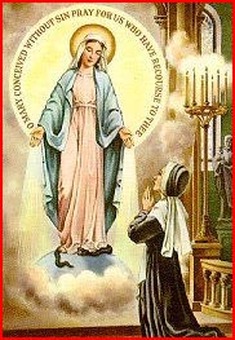 On November 27th, 1830, at the convent of the Daughters of Charity, on the Rue du Bac, in Paris, Our Lady appeared to St. Catherine Labouré, a novice in the community. She showed Catherine the design of a medal that she wanted to be made and distributed to all the world. The medal was initially known as the Medal of the Immaculate Conception or the Medal of Our Lady of Grace, but due to the many miracles that the medal seemed to produce, it received the popular title of "The Miraculous Medal." |
THIRD DAY OF THE NOVENA
New meditations for each day Theme: A Vigorous Rule of Life to Avoid Waste of Time Our Lady Says: Mary said to St. Catherine Labouré: "My child, I particularly love to shed graces upon your Community; I love it very much. It pains me that there are great abuses in regularity, that the rules are not observed, that there is much relaxation in the two Communities. Tell that to him who has charge of you, even though he is not the superior. He will be given charge of the Community in a special way; he must do everything he can to restore the rule in vigor. Tell him for me to guard against useless reading, loss of time, and visits." St. Catherine Labouré's "Rule of Life" in the Convent: Humanly speaking, Catherine could have had no misgivings about the physical demands of the life. The Sisters rose at four o'clock; but so had she, all her life. They cooked and scrubbed and labored hard; yet Catherine had known no other way of life at home. They observed long silences; she was quiet and reserved by nature. The outward trappings of the rule could cause her no alarm. We see here, what seems to us to be, a strict way of life. Long hours and hard work. Yet with all that Our Lady was still displeased! She says: "It pains me that there are great abuses in regularity, that the rules are not observed, that there is much relaxation." Meditation: Though you may not be a religious and you do not wear a religious habit, like St. Catherine, you are nevertheless a creature of habit. A habit means a frequent repetition of an action. A habit that is good, is known as a virtue; a habit that is bad, is known as a vice. Good habits often go against the grain of our not-so-good tendencies. The formation of good habits often needs assistance, like a sprained ankle needs crutches. The crutches for forming good habits are rules. If there are no rules at home, at work and at school, then we can be sure chaos and problems will inevitably arise. The same is true of our spiritual life. We have been given the Ten Commandments (the Rules of God) and the Commandments of the Church (the Rules of God's Church). These are meant to help us cultivate the good habits (virtues) necessary to get to Heaven. One of the last things that is done during the Spiritual Exercises of St. Ignatius (i.e., the Ignatian Retreat) is the requirement for the retreatants to write down a Rule of Life that they will try to follow once the retreat is over. Below, we give an example of a Rule of Life as recommended by Our Lady's religious order of the Servites. This is not a Rule of Life for religious, but for LAY PEOPLE. Sit down before reading it! Not because it is long (which it is), but because it is likely to be a shock to our Liberal, laid-back, easy-going, lukewarm disposition that the modern world has clothed us with. Read at your own risk! We take no blame for persons fainting, undergoing heart palpitations, or even mild heart attacks! The Rules of Catholic Life based on The Servite Manual, Behold Thy Mother Imprimatur, 1959 1. As the right employment of time is of the greatest importance in the spiritual life, draw up for yourself, with the advice of your spiritual director [if you have one], a rule or order of the day, assigning to each duty its proper time; observe this rule punctually. 2. Begin the day by making the Sign of the Cross as soon as you wake, and by saying some short prayer such as: "O my God, I offer my heart and soul to Thee. Grant that during this day all my intentions, thoughts, words, and actions may be directed to the praise and service of Thy Divine Majesty." Rise diligently at the appointed time, dress yourself modestly, and then kneel down before the Crucifix and the image of Our Lady of Sorrows, and say your Morning Prayers: 3. If your occupations and condition of life allow you, make a daily meditation for at least a quarter of an hour or half an hour. Meditate especially on the four last things; the Life and Passion of Our Blessed Lord; the virtues, privileges, and sorrows of Our Blessed Lady; and on feast days, on the mystery or Saint of the day. 4. You should also hear Mass, if you have time and opportunity; for to hear Mass is by far the best and most profitable of all devotions. 5. During the day endeavor to dwell in the Divine Presence. Sanctify your ordinary actions and employments of the day, by offering them to God in the beginning, and often raising up your heart to Him whilst you are about them, and saying some short prayer. 6. As to your eating, drinking, sleeping and amusements, use all these things with moderation, and with a desire to please God. Be faithful to the Christian practice of saying Grace before and after meals. 7. Every day endeavor, during at least a quarter of an hour or more, to make a spiritual reading from the Holy Gospel, the Lives of the Saints, and other spiritual works, which nourish our faith and piety, and arm us against the false maxims of the world. 8. If possible, recite daily the Crown of the Seven Dolors. Never forget the Angelus or Regina Coeli, in the morning, at noon, and in the evening. 9. Avoid dangerous occasions, companies, and conversations, and keep a strict guard over your senses, especially the eyes and the tongue. Be not idle, "for idleness hath brought much evil" (Ecclesiasticus. 33:29.) Do not waste your time in profane, or light reading, which but too often is a poison to the soul. 10. When you find yourself tempted to sin, make the Sign of the Cross on your heart, and call on God as earnestly as you can, saying "Lord, save me, or I perish;" invoking also the holy names of Jesus and Mary. Then, in order to forget the temptation, give all your attention to the work you are about, or occupy it with holy thoughts, such as the Passion of Jesus, the Sorrows of Mary, or death and eternity. 11. If unfortunately you have fallen into sin, be not discouraged; but cast yourself in spirit at the feet of Christ, and humbly beg His pardon by a sincere Act of Contrition; and in the case of mortal sin, go to Confession as soon as possible. 12. When God sends you any cross or humiliation, sickness or pain, accept it with resignation from His hand, offer it up to Him, in union with Jesus and Mary, saying: "Lord, Thy will be done; I take this for my sins. May I suffer patiently with Jesus and Mary." 13. Every evening, if you can, pay a visit to the Blessed Sacrament, and to the Altar of our Blessed Lady, as this practice is most sanctifying and the source of many a choice grace. If not, as is the case for most of us today, enthrone an image of the Sacred Heart in your home in a special place. Have a votive candle thereto light and make an evening visit. 14. Finish the day, as you have begun, by kneeling down and saying your Night Prayers. Examine carefully your conscience, humbly ask pardon of God for the faults of the day, and take good resolutions. Then observe due modesty in going to bed, occupy yourself with the thoughts of death, and endeavor to compose yourself to rest at the foot of the Cross near Our Lady of Sorrows, giving your last thoughts to your crucified Savior and His afflicted Mother. 15. On Sundays and Holy Days give more time to prayer and works of charity, hear the Word of God, and attend as much as possible all the Masses and other devotions if available. Avoid manual labor that is absolutely not necessary, likewise shopping. 16. Go to Confession and receive Holy Communion at least once a month, and on the principal feasts of the year. Go oftener, if you can, even daily. For this, and everything else pertaining to your soul, choose a good and prudent confessor, whose advice you should seek and faithfully follow. 17. If you can, make a spiritual retreat once a year, under the guidance of an enlightened director. It is also a very salutary practice to make a monthly retreat, choosing for it the day when you are less busy. In today's modern world, Sunday would be seem to be the best available day for doing this. 18. Lastly, if you fall seriously ill, think that it may be your last illness, and make the sacrifice of your life to God, resigning yourself entirely to His holy will. Make a good Confession and receive Holy Communion, as if it was the last time, even before there is any danger. And when you are in danger, do not delay receiving the last Sacraments, but be the first to ask for them, so as to receive them in your full senses. And in order to learn how to die well, than which nothing is more important, make the exercise of Preparation for Death in every monthly retreat. 19. Say five decades of the Rosary, either in the morning, the evening or during the day, incorporating rules 3 and 14 where appropriate. [However, remember that in bygone days, people regarded the Rosary as being 15 decades and not just 5 decades]. Recite your Rosary slowly and deliberately, not hurriedly and distractedly in order to get it done on a technicality. If distractions occur, quickly ask Our Lord and Our Lady their grace to dismiss it and do not let these annoyances disturb this time in their arms. Remember that one devout Hail Mary is of more value than a hurried, half-hearted Rosary. Never omit praying for the relief of the Holy Souls in Purgatory: an act of charity that is obligatory and ought to be a welcomed work and not considered merely obligatory. 20. Read this Rule of Life from time to time, in order not to forget it: see how you observe it, and take resolutions accordingly. Please note that these rules are fundamental, but they may be modified due to special circumstances beyond our control, such as sick children or spouse that occupy much time. Do not miss the Rosary, but you can choose rather to not read a salutary work for a quarter of an hour, for example. You may want to recite the Angelus only at noon. Make a beginning and do what you can and the rest will come in short order as best as can be given the exigency of the crisis in the Church. Thus, daily Mass is not a possibility for most Catholics, simply because it is not available every single day any longer. But crosses and humiliations we will always have. "THIS DO AND THOU SHALT LIVE." (Luke 10:28). Do this, and you will also be well on your way to avoiding Purgatory too! Once again, we stress that this rule is not for religious (priests, monks and nuns) but for LAY PEOPLE. Such a rule shows God that we truly take our religion seriously, and are trying to love God with our whole heart, soul, strength and mind (Luke 10:27). We could well reflect on Our Lady's words at La Salette, where she complained that people do not take their religions seriously enough and that the only thing most people are concerned about is amusements. Note too her words to St. Catherine also: "There are great abuses in regularity, ... rules are not observed, ... there is much relaxation ... guard against useless reading, loss of time, and visits." [Quiet Reflection] Our Prayer: O Immaculate Virgin Mary, Mother of Our Lord Jesus and our Mother, penetrated with the most lively confidence in thy all-powerful and never-failing intercession, manifested so often through the Miraculous Medal, we, thy loving and trustful children, implore thee to obtain for us the graces and favors we ask during this Novena, if they be beneficial to our immortal souls, and the souls for whom we pray. [Mention Intention] Thou knowest, O Mary, how often our souls have been the sanctuaries of thy Son, Who hates iniquity. Obtain for us then a deep hatred of sin and that purity of heart, which will attach us to God alone, so that our every thought, word and deed, may tend to His greater glory. Obtain for us, also, a spirit of prayer and self-denial that we may recover, by penance, what we have lost by sin and, at length, attain to that blessed abode, where thou art the Queen of Angels and of men. Amen. Pray: Say the Our Father and the Hail Mary. Final Invocation: O Mary conceived without sin, pray for us who have recourse to thee. |
|
|
FOURTH DAY OF THE NOVENA
New meditations for each day Theme: The Consequences of Ignoring Heaven's Requests Our Lady Says: Mary said to St. Catherine Labouré: “My child , times are evil in France and in the world. The side of Our Lord will be pierced anew. The Cross will be treated with contempt; they will hurl it to the ground. Blood will flow; they will open up again the side of Our Lord. The streets will run with blood. Monseigneur the Archbishop will be stripped of his garments. (Here the Blessed Virgin could no longer speak; her anguish was depicted in her face.) My child, the whole world will be in sadness. The whole world will be afflicted with tribulations [the whole world will be plunged into every kind of misery]." Our Lady would say at La Salette (16 years later): "If my people do not wish to submit themselves, I am forced to let go of the hand of my Son. It is so heavy and weighs me down so much I can no longer keep hold of it ... Woe to the inhabitants of the earth! God will exhaust His wrath upon them, and no one will be able to escape so many afflictions together. The chiefs, the leaders of the people of God, have neglected prayer and penance, and the devil has bedimmed their intelligence. They have become wandering stars which the old devil will drag along with his tail to make them perish. God will allow the old serpent to cause divisions among those who reign in every society and in every family. Physical and moral agonies will be suffered. God will abandon mankind to itself and will send punishments which will follow one after the other for more than thirty-five years. The society of men is on the eve of the most terrible scourges and of gravest events. Mankind must expect to be ruled with an iron rod and to drink from the chalice of the wrath of God ... Blood will flow on all sides. Churches will be locked up or desecrated. Priests and religious orders will be hunted down, and made to die a cruel death. Several will abandon the faith, and a great number of priests and members of religious orders will break away from the true religion; among these people there will even be bishops .. For a while the Church will yield to large persecution, a time of darkness and the Church will witness a frightful crisis ... there will be desecration of holy places. In convents, the flowers of the Church will decompose and the devil will make himself like the King of all hearts ... France, Italy, Spain, and England will be at war. Blood will flow in the streets. Frenchman will fight Frenchman, Italian will fight Italian. A general war will follow which will be appalling. For a time, God will cease to remember France and Italy because the Gospel of Jesus Christ has been forgotten." Meditation: Our Lady appeared to St. Catherine Labouré in 1830, just over 40 years after the French Revolution had begin in 1789. What had begun, had not really finished and the effects of the Revolution were still being felt like the after-shocks of an earthquake. The French Revolution was a punishment from God, for France having refused Jesus' request to King Louis IV, in 1689, to consecrate the nation to the Scared Heart of Jesus. He neglected to do so, and therefore, 100 years afterwards, God allowed the monarchy to be mercilessly murdered as the Revolution rose from below. This is much like Adam and Eve. The disobeyed God, and so God allowed nature to rebel against Adam and Eve, with God's protective Providence being withdrawn from them as nature punished Adam, Eve and all their descendants for their refusal of God's request. Similarly, in our own lives, God has, is or will be punishing our refusal to obey His wishes. He wants the whole world to be devoted to Mary, especially under the twin titles of the Sorrowful and Immaculate Heart, but the world is too busy with its vanities to listen to God. He want the Pope to consecrate Russia to the Immaculate Heart of Mary, yet one Pope after another has ignored that request. We are fast approaching the 100 years mark, from the day those requests were made. 1917 and soon it will be 2017. The King of France lost his authority and his life; will the Pope lose his authority, his faith and his life? The words of Our Lady of La Salette and Fatima seem to indicate that: "Rome will lose the Faith ... the Holy Father will have much to suffer." Sister Lucia sees the Holy Father walking across the dead bodies of countless Catholics, bishops, priests, monks, nuns, and laity. Already there is "civil war" in many familes, over religious and spiritual matters. Just as Our Lord predicted: "Think ye, that I am come to give peace on earth? I tell you, no; but separation. For there shall be from henceforth five in one house divided: three against two, and two against three. The father shall be divided against the son, and the son against his father, the mother against the daughter, and the daughter against the mother, the mother in law against her daughter in law, and the daughter in law against her mother in law." (Luke 12:51-53) ... "Brother shall betray his brother unto death, and the father his son; and children shall rise up against the parents, and shall work their death. And you shall be hated by all men for my name' s sake." (Mark 113:12-13). War is a punishment for sin. At Fatima, Our Lady said that God is offended more than enough. Yet since 1917, sins has raced forward even far more than inflation! Rather than sin less, the world sins more! This is why God will punish the Earth, as Our Lady had warned us, in an unprecedented manner. Yet God is always balanced, when there is a notable increase in His justice, there is also a proportionate increase in His mercy. The Miraculous Medal is an act of God's mercy. As Our Lady promised, major graces will come to mankind through it. We will not escape His justice; let us make sure we don't escape His mercy—get yourself a new stock (or your first stock) of Miraculous Medals before the feast arrives on the 27th of this month. More about the Medal tomorrow! [Quiet Reflection] Our Prayer: O Immaculate Virgin Mary, Mother of Our Lord Jesus and our Mother, penetrated with the most lively confidence in thy all-powerful and never-failing intercession, manifested so often through the Miraculous Medal, we, thy loving and trustful children, implore thee to obtain for us the graces and favors we ask during this Novena, if they be beneficial to our immortal souls, and the souls for whom we pray. [Mention Intention] Thou knowest, O Mary, how often our souls have been the sanctuaries of thy Son, Who hates iniquity. Obtain for us then a deep hatred of sin and that purity of heart, which will attach us to God alone, so that our every thought, word and deed, may tend to His greater glory. Obtain for us, also, a spirit of prayer and self-denial that we may recover, by penance, what we have lost by sin and, at length, attain to that blessed abode, where thou art the Queen of Angels and of men. Amen. Pray: Say the Our Father and the Hail Mary. Final Invocation: O Mary conceived without sin, pray for us who have recourse to thee. |
|
|
FIFTH DAY OF THE NOVENA
New meditations for each day Theme: The Meaning of the Miraculous Medal Our Lady Says: Mary said to St. Catherine Labouré: “Have a medal struck upon this model." St. Catherine Labouré Says: ""There now formed around the Blessed Virgin a frame rather oval in shape on which were written in letters of gold these words: ' O Mary conceived without sin, pray for us who have recourse to Thee.' Then a voice said to me: ' Have a medal struck upon this model. All those who wear it, when it is blessed, will receive great graces especially if they wear it round the neck. Those who repeat this prayer with devotion, will be, in a special manner, under the protection of the Mother of God. Graces will be abundantly bestowed upon those who have confidence.' "At the same instant, the oval frame seemed to turn around. Then I saw on the back of it the letter 'M', surmounted by a cross, with a crossbar beneath it, and under the monogram of the name of Mary, the Holy Hearts of Jesus and of His Mother; the first surrounded by a crown of thorns and the second transpierced by a sword. I was anxious to know what words must be placed on the reverse side of the medal and, after many prayers, one day, in meditation, I seemed to hear a voice which said to me: ' The 'M' with the Cross and the two Hearts tell enough.' " Meditation: The "Miraculous Medal" is not the 'official' name of the medal, but the name given to it by the popular appeal of the people, when it was realized how many miracles were being produced through it. The 'official' name of the medal was "The Medal of the Immaculate Conception" or the Medal of Our Lady of Grace. These, too, are most appropriate titles, as we shall show in the following explanation on the meaning and symbolism of the all the elements shown on both sides of the medal. The Front Side of the Medal ► Mary stands on a globe, which represents the world in general and France in particular. ► Mary is crushing a serpent beneath her feet. This signifies her total power over Satan and is a figure or symbol of the forthcoming Triumph of the Immaculate Heart of Mary. ► Describing the original vision, Catherine said the Blessed Mother appeared radiant as a sunrise, "in all her perfect beauty." This is a result of the perfection achieved in Heaven, where Mary was assumed after her death. ► Rays shoot out from the many jeweled rings on Mary's hands. This is a symbol of Mary being the Mediatrix of all Grace. All graces come to us through her hands. Our Lady told Catherine that the rays shining out from the rings, "symbolize the graces I shed upon those who ask for them." Yet some rings gave out no rays (or dull rays), which are graces that God would give to us through Mary's hands, but Our Lady said that we are negligent in asking for them, and therefore, since we do not ask, we do not get. ► The words from the vision form an oval frame around Mary: "O Mary, conceived without sin, pray for us who have recourse to thee." This points to her Immaculate Conception, which, 24 years later, in 1854, would be pronounced to be a dogma by the Church. At Lourdes, 4 years later, in 1858, Our Lady would confirm the Church's act, by calling herself the Immaculate Conception. ► Seen as a whole, the elements of the front design contain major Marian teachings and beliefs: (a) her Immaculate Conception; (b) her Assumption; (c) Mediatrix of All Graces; (d) her Divine Maternity; (e) her Spiritual Maternity to mankind; (f) Queen of Heaven and Earth; (g) Mary as Protectress and Vanquisher of Satan. The Reverse Side of the Medal ► A cross-and-bar surmounts a large, bold "M" ► 12 stars disperse around the perimeter. 12 is a number of perfection. Hence the 12 Tribes of Israel; the Twelve Apostles; the twelve hours in a day and in a night. Our Lady is perfection. Conceived without sin, she also lived without sinning. She was as full of grace as she could be when she was conceived and from that moment she grew in that fullness of grace until the last breath of her sinless life. St. Louis de Montfort, in his book True Devotion to Mary, speaks of "the Little Crown of the Blessed Virgin, composed of three Our Fathers and twelve Hail Mary’s, in honor of Our Lady’s twelve privileges and grandeurs. This is a very ancient practice and it has its foundation in Holy Scripture. St. John saw a woman crowned with twelve stars, clothed with the sun, and with the moon under her feet (Apocalypse 12:1); and this woman, according to the interpreters, was the most holy Virgin." ► The Twelve Star Devotion is of baroque origin and expression. It originated with the special attention attributed to Mary as Regina Mundi (Queen of the World) or Imperatrix Mundi (Empress of the World). The twelve stars are seen in reference to the graces, privileges and charisms received by Our Lady from God. Mary, the Queen of Heaven, is crowned with her perfections, one star for each one of the perfections. Here are these twelve perfections which became the object of the Twelve-Star Devotion:
► Two hearts are depicted underneath the "M," the left lapped with a crown of thorns, the right skewed by a sword. These are, of course, the Sacred Heart of Jesus and the Sorrowful and Immaculate Heart of Mary. Notice that they both symbolize suffering: Jesus' Heart is surrounded and pierced by thorns; Mary's Heart is pierced through by a sword. The fact that they both suffered for our Redemption, is both a command and an encouragement for us to suffer also, if we wish to follow them to Heaven. ► From each Heart, a flame bursts forth from the top. Fire, of course is a symbol of God, the Divinity. God chose to appear to Moses in the guise of a burning bush, whereby the fire engulfed the bush but did not destroy it. The Holy Ghost came to Our Lady and the Apostles on Pentecost under the form of tongues of fire. The Sacred Heart itself showed itself to St. Margaret Mary, as being on fire with love. That the Holy Trinity chooses fire to represent each Person of the Trinity, is very fitting, since, as the Bible tells us: "God is charity" (1 John 4:8) and Jesus said that "I am come to cast fire on the earth; and what will I, but that it be kindled?" (Luke 12:49). The two Hearts on the medal show the love of Jesus and Mary for each other and for us. As St. Thomas Aquinas says, love is reciprocal, meaning that it should be returned. Are we returning that love? How well? With all our heart, mind, soul and strength? ► The Cross symbolizes Christ and our redemption, with the bar under the cross being a sign of the earth. If we wish to follow Christ to Heaven, then we must carry the Cross with Him. "And He said to all: 'If any man will come after Me, let him deny himself, and take up his cross daily, and follow Me!' " (Luke 9:23). ► The “M” stands for Mary, and the interleaving of her initial and the cross shows Mary’s close involvement with Jesus and our world. In this, we see Mary’s part in our salvation and her role as mother of the Church. In that letter "M" we can also see some qualities of Mary that we should treasure especially: Mother, Mild, Merciful, Mournful, Majestic, Magnanimous, [Quiet Reflection] Our Prayer: O Immaculate Virgin Mary, Mother of Our Lord Jesus and our Mother, penetrated with the most lively confidence in thy all-powerful and never-failing intercession, manifested so often through the Miraculous Medal, we, thy loving and trustful children, implore thee to obtain for us the graces and favors we ask during this Novena, if they be beneficial to our immortal souls, and the souls for whom we pray. [Mention Intention] Thou knowest, O Mary, how often our souls have been the sanctuaries of thy Son, Who hates iniquity. Obtain for us then a deep hatred of sin and that purity of heart, which will attach us to God alone, so that our every thought, word and deed, may tend to His greater glory. Obtain for us, also, a spirit of prayer and self-denial that we may recover, by penance, what we have lost by sin and, at length, attain to that blessed abode, where thou art the Queen of Angels and of men. Amen. Pray: Say the Our Father and the Hail Mary. Final Invocation: O Mary conceived without sin, pray for us who have recourse to thee. |
|
SIXTH DAY OF THE NOVENA
New meditations for each day Theme: The Power of the Miraculous Medal Our Lady Says: Mary said to St. Catherine Labouré: "All who wear it will receive great graces; they should wear it around the neck. Graces will abound for those who wear it with confidence." St. Maimilian Kolbe Says: St. Maximilian Kolbe, who died in 1941, beatified by Pope Paul VI in 1973 and canonized by Pope John Paul II in 1982, performed great spiritual works through the use of the Miraculous Medal. He wrote: “At various times and in various trials the most Blessed Virgin Mary has come to the aid of her children, giving them different ways of attaining salvation more easily, and freeing others from the yoke of Satan. Now in this epoch of the Immaculate Conception the most Blessed Virgin has given mankind the ‘Miraculous Medal.’ Its Heavenly origin has been proved by countless miracles of healing and particularly conversion." Meditation: It was and is the fulfillment of this promise, the abundance of graces, that quickly endeared the Medal to the world. The spread of the Medal was so rapid and the flood of favors it let loose so startling, that the faithful gave it the name "Miraculous." The number of Medals minted since 1832, when it was first struck, is beyond all counting. It is easily in the hundreds of millions. The Medal is worn by Protestant and Jew as well as Catholic. Wonders worked through the Medal Archbishop de Quelen attributed to the Miraculous Medal the deathbed conversion of a publicly impenitent sinner, Baron Dominique de Riom de Frolhiac de Fourt de Pradt. The Archbishop had tried to see him on several occasions and had been rebuffed. So he took a Miraculous Medal with him, and was finally allowed in to see the Baron, who was so touched by grace that he repented and confessed his sins. The next day he received the Sacraments from the Archbishop and died in his arms in 1837. Another of the stupendous workings of the Miraculous Medal was the conversion of Alphonse Ratisbonne on January 20, 1842. On January 15 he had been prevailed upon to wear a Miraculous Medal and say the "Memorare." Alphonse was a staunch Jew, and had great antipathy for Catholicism. Yet on that day of January 20 he saw an apparition of the Blessed Virgin of the Miraculous Medal in all her dazzling glory, and his whole life was radically changed. Cardinal Patrizi, the Vicar of Rome, after a careful investigation, received Alphonse into the Church on January 31, 1942. Baptizing him, confirming him, and giving him First Communion. Alphonse became a priest and spent some thirty years in the Holy Land as a missionary to his own people. The wonders it works are as ordinary or as extraordinary as the needs and ills of mankind. Conversions to the Faith, repentance of hardened sinners, recognition of the Will of God, peace in homes, recoveries from illness acute and chronic, critical and minor-the catalogue is endless. Each wearer of the Medal has his own story to tell. Best of all, the Medal seems to have a special power for promoting and deepening personal devotion to the Mother of God. Thus it has not merely a passing or momentary effect on the soul it touches, but an effect which is so lasting as to be, in many cases, eternal. Under this aspect, it has assumed a mighty role in the reconversion of the world, for it betters the individual soul, and the world's goodness is exactly equal to the sum of all good hearts. Catherine Labouré is the perfect model of what Our Lady intended the Medal to do for mankind. As already stated, the Miraculous Medal is meant to sanctify those who wear it. Catherine Labouré is not a saint because she saw the Blessed Virgin, but because she cultivated devotion to her and allowed this devotion to influence her way of life. In so doing, she realized perfectly Our Lady's objective: not the performance of heroic, or even unusual, deeds by her clients, but the perfection of their ordinary states of life. Catherine's formula was very simple: she did what she was supposed to do; she did it as well as she could; and she did it for God. It is a formula that everyone can, and should, follow. No one pretends that it is easy; the pursuit of virtue entails self-discipline and sacrifice: but it is attainable. The sanctity of Catherine Labouré is proof. She is, therefore, the "Saint of Ordinary People," a flesh-and-blood rendering of the message of Mary to mankind through the Apparitions of the Miraculous Medal, a model for the salvation of the modern world. Mary Immaculate did not specifically ask for any set form of devotion beyond the wearing of the Medal. Therefore one must come to the conclusion that the medal itself provides the inspiration for devotion, for the medal is a lesson unto itself of the depth of love that we are to have for Jesus and Mary. [Quiet Reflection] Our Prayer: O Immaculate Virgin Mary, Mother of Our Lord Jesus and our Mother, penetrated with the most lively confidence in thy all-powerful and never-failing intercession, manifested so often through the Miraculous Medal, we, thy loving and trustful children, implore thee to obtain for us the graces and favors we ask during this Novena, if they be beneficial to our immortal souls, and the souls for whom we pray. [Mention Intention] Thou knowest, O Mary, how often our souls have been the sanctuaries of thy Son, Who hates iniquity. Obtain for us then a deep hatred of sin and that purity of heart, which will attach us to God alone, so that our every thought, word and deed, may tend to His greater glory. Obtain for us, also, a spirit of prayer and self-denial that we may recover, by penance, what we have lost by sin and, at length, attain to that blessed abode, where thou art the Queen of Angels and of men. Amen. Pray: Say the Our Father and the Hail Mary. Final Invocation: O Mary conceived without sin, pray for us who have recourse to thee. |
|
SEVENTH DAY OF THE NOVENA
New meditations for each day Theme: A Sign of Things to Come Our Lady Says: Mary said to St. Catherine Labouré: "The ball which you see represents the world, especially France, and each person in particular. These rays symbolize the graces I shed upon those who ask for them. The jewels which give no rays symbolize the graces that are not given because they are not asked for .. Those are the graces for which people forget to ask." St. Catherine Labouré Says: The Virgin was standing. She was of medium height, and clothed all in white. Her dress was of the whiteness of the dawn. A white veil covered her head and fell on either side to her feet. Under the veil her hair, in coils, was bound with a fillet ornamented with lace. Her feet rested on a white globe, that is to say half a globe, or at least I saw only half. There was also a serpent, green in color with yellow spots. The hands were raised to the height of the stomach and held, in a very relaxed manner and as if offering it to God, a golden ball surmounted with a little golden cross, which represented the world. Her eyes were now raised to Heaven, now lowered. All at once I saw rings on her fingers, three rings to each finger, the largest one near the base of the finger, one of medium size in the middle, the smallest one at the tip. Each ring was set with gems, some more beautiful than others; the larger gems emitted greater rays and the smaller gems, smaller rays; the rays bursting from all sides flooded the base, so that I could no longer see the feet of the Blessed Virgin. At this moment, while I was contemplating her, the Blessed Virgin lowered her eyes and looked at me. I heard a voice speaking these words: "This ball that you see represents the whole world, especially France, and each person in particular." I could not express what I felt at this, what I saw, the beauty and the brilliance of the dazzling rays. "They are the symbols of the graces I shed upon those who ask for them." This made me realize how right it was to pray to the Blessed Virgin and how generous she was to those who did pray to her, what graces she gave to those who asked for them, what joy she had in giving them. "The gems from which rays do not fall are the graces for which souls forget to ask," continued the voice. The golden ball disappeared in the brilliance of the sheaves of light bursting from all sides; the hands turned out and the arms were bent down under the weight of the treasures of grace obtained. Meditation: The globe carried by Our Lady represents the world, which should be crowned with the Cross of Christ. The gold color symbolizes the spiritual love or charity that should throughout the world and the love of the Cross that each and every soul should have. There is not redemption possible for the world without the Cross, as Jesus Himself said: "If any man will come after Me, let him deny himself, and take up his cross daily, and follow Me” (Luke 9:23). As the worldly amass gold and glory in it, so too should the true follower of Christ amass crosses and glory in them, as St. Paul writes: "God forbid that I should glory, save in the cross of Our Lord Jesus Christ; by whom the world is crucified to me, and I to the world” (Galatians 6:14). As Mary presented her Son to the Divine Father as He was dying on the Cross, so too does she present our death to the world through our countless crosses that detach us from the world that is an enemy of God's. “Know you not that the friendship of this world is the enemy of God?" (James 4:4). The Cross on the globe makes us think of Our Lady's words at Fatima, where she says that the Church will have to suffer; that many nations will be wiped-off the face of the Earth. At La Salette she warns: “Woe to the inhabitants of the earth! God will exhaust His wrath upon them, and no one will be able to escape so many afflictions together ... Blood will flow on all sides. Churches will be locked up or desecrated. Priests and religious orders will be hunted down, and made to die a cruel death ... At the first blow of His thundering sword; the mountains and all Nature will tremble in terror, for the disorders and crimes of men have pierced the vault of the Heavens. Paris will burn and Marseilles will be engulfed. Several cities will be shaken down and swallowed up by earthquakes. People will believe that all is lost. Nothing will be seen but murder, nothing will be heard but the clash of arms and blasphemy.” Satan's pride compelled him to reveal his hand in the destruction of Holy Russia from the start of the revolution. In 1905 when Catherine de Hueck Doherty was a nine year old girl living comfortably with her family in rural Russia, it was customary for pilgrims to walk long distances to pray at its many shrines. Traveling alone or in groups, many took little or no money and only a gourd of water, a loaf of rye bread and a pinch of salt, eating and drinking only once daily. When these were exhausted the holy pilgrims would beg for food as well as shelter in villages and farms along their way. One evening a single old woman pilgrim sought shelter at the farm of Catherine's family and the family and servants eagerly gathered to hear her tell of her pious adventures. Well into the evening, after relating many blessings received at the holy shrines, the woman told of passing through a thick forest with a growing sense of an evil presence that even set the forest creatures on edge. Around a bend another road joined hers and a single man walking in her direction joined her. Although she sensed some evil about him he behaved well. He didn't use a Christian greeting, just calling her Granny. When she told him of her holy pilgrimage he laughed about religion being superstition fed to peasants by priests to pacify them to accept the many injustices that afflicted them. He was eloquent and persuasive and she soon began to believe him. Then he began mocking the Blessed Mother and calling the virgin birth fiction and devotion to Mary idolatry. She quietly took a small bottle of holy water and sprinkled him with it in the name of Jesus and the Holy Trinity. He screamed, fell twisting to the ground and before vanishing cried out: "You old fool! All Russia will be covered with rivers of blood over the things I've said. Millions will think like I do. There will be moaning and groaning and tears all over this land. I am out to win it and win it I will. And neither your God nor your Blessed Virgin will be able to save it." The old woman fainted in terror. Awakening, she continued walking cautiously. Suddenly there was a very great light on the road, and a young woman, dressed just like me in a pilgrim's garb, with an icon on her breast, came up gently to my side. "Fear not, Grandma," she said, "it is true what the man said, but he was not a man. These things will come to pass so that Holy Russia may hang on the cross with my Son to redeem the world. The only way the world can be redeemed is through suffering with my Son. Fear not. There will come a day when, under the sign of my Son, I will lead Russia to show my Son's face to the world." Then she vanished too, and I saw the lights of the village. At her alleged apparition at Akita, in 1973, Our Lady is supposed to have said: "As I told you, if men do not repent and better themselves, the Father will inflict a terrible punishment on all of humanity. It will be a punishment greater than the Deluge, such as one will never have seen before. Fire will fall from the sky and will wipe out a great part of humanity, the good as well as the bad, sparing neither priests nor faithful. The survivors will find themselves so desolate that they will envy the dead. The only weapons which will remain for you will be the Rosary and the Sign left by my Son." That sign, left by her Son, is thought by some to be the Holy Eucharist in some form, and by others it is thought to be the Sign of the Cross. However, the two are reconcilable into one entity, because the Holy Eucharist is both a Sacrament and a Sacrifice. It is in the Holy Sacrifice of the Mass that Christ both re-offers to God the Father His Sacrifice of Calvary, and, at the same time feeds us with the Sacrament of the His Body, Blood, Soul and Divinity in the Holy Eucharist. These two helps, of which Our Lady speaks (the Rosary and the Holy Eucharist), are also represented in the vision that St. John Bosco had of the Ark of the Church in latter times, where the Church, represented by a ship in a stormy sea is being attacked on all sides by pirates. The pope finally sails the ship to safety and anchors it to two pillars that miraculously emerged from the sea. On one pillar was the Holy Eucharist; on the other pillar was the Blessed Virgin Mary. Our remedies are simply Jesus and Mary in all the forms that devotion to them can embrace: (1) the Sacred Heart of Jesus and the Immaculate Heart of Mary; (2) the Holy Mass of Jesus and the Holy Rosary of Mary; (3) consecration to the Sacred Heart and consecration to the Immaculate Heart; (4) devotion to Jesus in the contemplating and receiving the Holy Eucharist, and devotion to Mary by contemplating and meditating upon the mysteries of the Holy Rosary. At another alleged apparition of Our Lady, at Garabandal, Our Lady is reported to have foretold three great supernatural events: the Warning, the Great Miracle, and the Great Chastisement. Whichever way you look at it, purification and a return to a true love of God will only come about through a great suffering inflicted upon the entire globe. God chastises those whom He loves: "For whom the Lord loveth, He chastiseth" (Proverbs 3:12). [Quiet Reflection] Our Prayer: O Immaculate Virgin Mary, Mother of Our Lord Jesus and our Mother, penetrated with the most lively confidence in thy all-powerful and never-failing intercession, manifested so often through the Miraculous Medal, we, thy loving and trustful children, implore thee to obtain for us the graces and favors we ask during this Novena, if they be beneficial to our immortal souls, and the souls for whom we pray. [Mention Intention] Thou knowest, O Mary, how often our souls have been the sanctuaries of thy Son, Who hates iniquity. Obtain for us then a deep hatred of sin and that purity of heart, which will attach us to God alone, so that our every thought, word and deed, may tend to His greater glory. Obtain for us, also, a spirit of prayer and self-denial that we may recover, by penance, what we have lost by sin and, at length, attain to that blessed abode, where thou art the Queen of Angels and of men. Amen. Pray: Say the Our Father and the Hail Mary. Final Invocation: O Mary conceived without sin, pray for us who have recourse to thee. |
|
EIGHTH DAY OF THE NOVENA
New meditations for each day Theme: The Miracles and Theology of the Medal Our Lady Says: When Our Lady gave the design of the medal to Saint Catherine Labouré she said, “Now it must be given to the whole world and to every person.” St. Catherine Labouré Says: After St. Catherine had been shown the design of the Medal by Our Lady, she reported everything to her spiritual director, Father Aladel. However, it took two years for him to be convinced, and to his surprise he promptly received permission from the Archbishop to fulfill Catherine’s request. Meditation: Yesterday we stated that the globe carried by Our Lady represented the world, which should be crowned with the Cross of Christ. Yet to accept and successfully carry the Cross of Christ in our lives, we need the help of grace, for Jesus said: "Without Me you can do nothing” (John 15:5). Our Lady is the Mediatrix of all Grace, meaning that all graces pass through her hands. This is what was symbolized by the rays of light shining from the rings on the fingers of her hands. Grace shone forth from her hands. The first 2,000 medals were delivered on 30th June, 1832. This coincided with an outbreak of a deadly epidemic of cholera in Paris which claimed 20,000 lives. The Sisters began distributing the first medals and many cures were reported, leading to the people of Paris starting to call the medal ‘miraculous’. 1. In Paris, an 8 year old girl was the only one in her class that did not wear a medal and was the only one who caught cholera. She was given a medal and returned to school the next day. 2. A woman who was pregnant contracted cholera and was thought close to death. After being given the medal she had a smooth delivery and both mother and baby were found to be healthy. 3. A child who had been unable to walk was healed when he wore the medal on the first day of a novena. 4. One famous case which everyone acclaimed as a miracle was the conversion of a staunch Jew named Alphonse Ratisbonne. He hated Christianity but, despite his better judgement, had been persuaded to wear the medal round his neck. On 20th January, 1842, when visiting a church in Rome, he was privileged to see an apparition of the Blessed Virgin of the Miraculous Medal. Like St. Paul at Damascus, he was instantly converted and went on to become a humble priest. By the year 1836 several millions had been sold. The spreading of the Medal was also the spreading of grace and miracles. What was true then, can also be true for our day. The Medal contains the totality of Marian theology and the essential elements of Christian revelation. Some have called the Medal “a small bible” and “the catechism of the people.” Without twisting, forcing or exaggerating the words of the text and the symbols of the Medal, certain biblical texts come to mind when reflecting on the Medal's texts and design: (1) the woman with the twelve stars, with the moon under her feet and crushing a snake as described in the Book of the Apocalypse; (2) the promise of a descendant of a woman conquering Satan as made in the book of Genesis; (3) the prophecy of the elderly Simeon in the temple: "And you yourself a sword will pierce" (the pierced heart); (4) the active presence of Mary at the culminating moment of the redemptive work of Jesus on Calvary (the cross with the “M” and the two hearts); (5) the Immaculate Conception's mystery proclaimed in the ejaculation “O Mary conceived without sin”; (6) Mary's function as intercessor and distributor of the gift of divine grace as seen at Cana (the globe in her hands and the open arms shedding rays of light on the earth); (7) Mother of the Redeemer and of the redeemed (the Church) or (8) the new Eve (Mary) united to the new Adam (Christ); (9) the two hearts and the cross with the “M,” showing the redemptive suffering of Christ to which we must unite; (10) the sphere upon which Our Lady stands shows her superiority over the world, of which is Queen; (11) the circle of twelve stars as symbol of the Twelve Apostles and the chief virtues of Mary, twelve being a number of perfection. Truly, the Miraculous Medal is wonderful gift from Heaven. Our Lady said: “Now it must be given to the whole world and to every person.” What will our response be? Will we bury it in our own pocket, like the servant buried the talent that his master gave him (The Parable of the Talents)? Or will we make use of it, just like the two other servants made good use of the talents that they had been given? The salvation of some soul(s) may depend upon our mission to both distribute and explain the Miraculous Medal. However, do not stop there! Go further and spread the True Devotion to Mary, which is to the Miraculous Medal what a tree is to a seed. The little Miraculous Medal is only a little seed, like the grain of mustard seed, the smallest of seeds, that Our Lord refers to in the Bible, which, once fully grown, is the largest of the plants. Similarly, the Miraculous Medal, a tiny medal, should be the seed of True Devotion to Mary, which, once fully grown, will be the remedy for the evils of our times. What are we doing to (1) practice the devotion ourselves, and (2) spread the devotion amongst those around us? The Ven. Fr. Faber writes in the Preface of his personal translation of St. Louis de Montfort's book, True Devotion to Mary: "But what is the remedy that is wanted? What is the remedy indicated by God Himself? If we may rely on the disclosures of the saints, it is an immense increase of devotion to our Blessed Lady; but, remember, nothing short of an immense one. Here in England, Mary is not half enough preached. Devotion to her is low and thin and poor. It is frightened out of its wits by the sneers of heresy. It is always invoking human respect and carnal prudence, wishing to make Mary so little of a Mary that Protestants may feel at ease about her. Its ignorance of theology makes it unsubstantial and unworthy. It is not the prominent characteristic of our religion which it ought to be. It has no faith in itself. Hence it is that Jesus is not loved, that heretics are not converted, that the Church is not exalted; that souls which might be saints wither and dwindle; that the Sacraments are not rightly frequented, or souls enthusiastically evangelized. "Jesus is obscured because Mary is kept in the background. Thousands of souls perish because Mary is withheld from them. It is the miserable, unworthy shadow which we call our devotion to the Blessed Virgin that is the cause of all these wants and blights, these evils and omissions and declines. Yet, if we are to believe the revelations of the saints, God is pressing for a greater, a wider, a stronger, quite another devotion to His Blessed Mother. I cannot think of a higher work or a broader vocation for anyone than the simple spreading of this peculiar devotion of the Venerable Grignion de Montfort. Let a man but try it for himself, and his surprise at the graces it brings with it, and the transformations it causes in his soul, will soon convince him of its otherwise almost incredible efficacy as a means for the salvation of men, and for the coming of the kingdom of Christ. Oh, if Mary were but known, there would be no coldness to Jesus then! Oh, if Mary were but known, how much more wonderful would be our faith, and how different would our Communions be! Oh, if Mary were but known, how much happier, how much holier, how much less worldly should we be, and how much more should we be living images of our sole Lord and Saviour, her dearest and most blessed Son!" (Ven. Fr. Faber, Preface, True Devotion to Mary). Finally, it is no small matter to note that the Miraculous Medal is one of only three Sacramentals specially honored by the Church. The Medal received liturgical approbation when a Mass and Office were assigned in its honor at the direction of Aloisi Cardinal Masella, Prefect of the Sacred Congregation of Rites, in 1895. It is one of only three sacramentals in the history of the Church to be thus liturgically honored, sharing its distinction with the Rosary and the Brown Scapular. It is, as we said above, "a small bible" and "the catechism of the people." Let us put it (and the True Devotion to Mary) into the hands of everyone we know. [Quiet Reflection] Our Prayer: O Immaculate Virgin Mary, Mother of Our Lord Jesus and our Mother, penetrated with the most lively confidence in thy all-powerful and never-failing intercession, manifested so often through the Miraculous Medal, we, thy loving and trustful children, implore thee to obtain for us the graces and favors we ask during this Novena, if they be beneficial to our immortal souls, and the souls for whom we pray. [Mention Intention] Thou knowest, O Mary, how often our souls have been the sanctuaries of thy Son, Who hates iniquity. Obtain for us then a deep hatred of sin and that purity of heart, which will attach us to God alone, so that our every thought, word and deed, may tend to His greater glory. Obtain for us, also, a spirit of prayer and self-denial that we may recover, by penance, what we have lost by sin and, at length, attain to that blessed abode, where thou art the Queen of Angels and of men. Amen. Pray: Say the Our Father and the Hail Mary. Final Invocation: O Mary conceived without sin, pray for us who have recourse to thee. |
|
NINTH DAY OF THE NOVENA
New meditations for each day Theme: Finding Help and Answers at the Altar of God Our Lady Says: "Come to the foot of the altar. Here graces will be shed on all who ask for them. There graces will be shed upon all, great and small, who ask for them. Especially will graces be shed upon those who ask for them with confidence and fervor." St. Catherine Labouré Says: After St. Catherine had been shown the design of the Medal by Our Lady, she reported everything to her spiritual director, Father Aladel. However, it took two years for him to be convinced, and to his surprise he promptly received permission from the Archbishop to fulfill Catherine’s request. Meditation: St. Catherine had already, for a long time, built an altar in her heart. The altar of God was very important to her. When she was still living at home and had to care for the household after the death of her mother, even though she had a work-load that would make most of us wilt under its pressure, each morning Catherine walked some six miles in the predawn darkness to Mass. Throughout the day she managed to slip away to the village chapel across the lane from her home. How easily we excuse ourselves from visiting the Blessed Sacrament on the pretext that we are too busy! Yet Jesus did not praise the busy, busy Martha as much as He praised her sister, Mary, who was sitting at His feet, contemplating His words. “A certain woman, named Martha, received Him into her house. And she had a sister called Mary, who sitting also at the Lord’s feet, heard His word. But Martha was busy about much serving. Who stood and said: 'Lord, hast thou no care that my sister hath left me alone to serve? Speak to her therefore, that she help me!' And the Lord answering, said to her: 'Martha, Martha, thou art careful, and art troubled about many things: but one thing is necessary. Mary hath chosen the best part, which shall not be taken away from her!' ” (Luke 10:38-42). The Altar, especially if the Blessed Sacrament is reserved on the altar in the tabernacle, is a place where two worlds meet: Heaven and Earth. It is the gateway to Heaven; it is a foretaste of Heaven; it is the earthly throne of the King of Heaven and Earth. There, on the altar, He resides day and night, patiently waiting for His subjects to come and adore Him, to love Him, to thank Him, to ask of Him, and to make reparation to Him. Yet, today, more than ever, He is largely forgotten and ignored by most of the Catholic world; and those who do come, often can't wait to leave and go do something "more exciting" in contrast to the "boredom" they find sitting in the church or chapel, before the altar and throne of Christ their King. On December 21, 1674, Our Lord appeared to St. Margaret Mary Alacoque (16447-1690) and manifested His love for mankind to her. During the next 13 months he appeared to her at intervals. His human heart was to be the symbol of his divine-human love. By her own love she was to make up for the coldness and ingratitude of the world—by frequent and loving Holy Communion, especially on the first Friday of each month, and by an hour's vigil of prayer every Thursday night in memory of his agony and isolation in Gethsemane. The Sacred Heart said to St. Margaret Mary: "Behold this Heart which has so loved men that it has spared nothing, even to exhausting and consuming itself, in order to testify its love. In return, I receive from the greater part only ingratitude, by their irreverence and sacrileges, and by the coldness and contempt they have for Me in this Sacrament of Love.... I come into the heart I have given you, in order that, through your fervor, you may atone for the offenses which I have received from lukewarm and slothful hearts that dishonor Me in the Blessed Sacrament." Today that lukewarmness, indifference, ingratitude and irreverence is worse than ever. The offenses and sacrileges have piled up, like a Tower of Babylon, piercing the heavens and provoking the vengeance of God. Yet Our Lord can be appeased by a true attention, love and devotion to His presence upon our altars. Are we part of the problem, or will we be part of the solution. Our Lord told us: “For where your treasure is, there will your heart be also.” (Luke 12:34). Where is my treasure? On the altar? Or elsewhere? Our Lady pleads with us to see and recognize our treasure as being on the altar and in the tabernacle: "Come to the foot of the altar. Here graces will be shed on all who ask for them. There graces will be shed upon all, great and small, who ask for them. Especially will graces be shed upon those who ask for them with confidence and fervor." Let us not disappoint our Mother, but rather let us disappoint the father of lies, the devil, by going often to the Altar of God. [Quiet Reflection] Our Prayer: O Immaculate Virgin Mary, Mother of Our Lord Jesus and our Mother, penetrated with the most lively confidence in thy all-powerful and never-failing intercession, manifested so often through the Miraculous Medal, we, thy loving and trustful children, implore thee to obtain for us the graces and favors we ask during this Novena, if they be beneficial to our immortal souls, and the souls for whom we pray. [Mention Intention] Thou knowest, O Mary, how often our souls have been the sanctuaries of thy Son, Who hates iniquity. Obtain for us then a deep hatred of sin and that purity of heart, which will attach us to God alone, so that our every thought, word and deed, may tend to His greater glory. Obtain for us, also, a spirit of prayer and self-denial that we may recover, by penance, what we have lost by sin and, at length, attain to that blessed abode, where thou art the Queen of Angels and of men. Amen. Pray: Say the Our Father and the Hail Mary. Final Invocation: O Mary conceived without sin, pray for us who have recourse to thee. |
Web Hosting by Just Host

